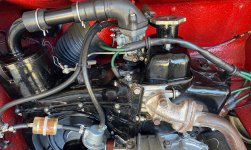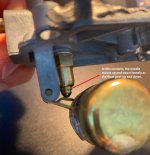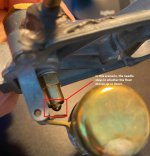Hi everyone,
I have an idling problem with my Fiat, and I was wondering if anyone here can help guide me. I’m not a mechanic but based on everything I’ve read on this forum, I was able to get my engine running, at least.
I have a 1970 Fiat 500L with a 126A engine (595cc) and a 28 IMB carburetor, named Bellucci. According to the previous owner, this car used to run but I’m not sure how or for how long. The car sat for several years in his garage without it being started, so I thought it was a perfect idea to buy it from him.
I have taken the carburetor down and cleaned it out entirely. I soaked it, removed all debris, and made sure that both the choke and throttle levers snapped back into place without any hesitation. The float needle has been replaced along with the gaskets. The plastic seat that sits between the carb and the engine used to have a crack in it so that’s been replaced as well. I used an air gun to dry all the cavities and used a needle to make sure nothing was blocking any holes to the best of my abilities. I’ve confirmed that fuel is making it into the carb by taking the top off after running the engine for 10 minutes. The carb bowl has plenty of clean fuel in it.
The gas tank has been fully cleaned out. A new fuel sender has been installed. A new air filter has been installed. A new battery has been installed. The oil has been changed. Spark plugs have been replaced and a new T line has been installed where fuel can circulate from the carb back into the main fuel line. The fuel pressure is strong. I have not touched the distributor nor made any adjustments to it. At this point, I'm 30% an IT guy and 70% a wannabe mechanic and I'm starting to rethink my life's decisions.
I get in the car, turn the key to the on position, pull the choke lever up, the dashboard displays the “G” letter along with the word “press.” I push the gas pedal all the way down and pull the start lever and the engine starts to crank. Usually after the second attempt, the engine starts running. After the engine runs for a minute with my foot on the gas, I gradually push the choke lever down until it’s completely down. Then I get ready, take my foot off the gas, and immediately make it to the back of the car only to push the throttle down by hand to keep the engine running. If I’m late by a second, the engine dies. This happens whether the engine is hot or cold.
With the throttle down with one hand, I get around 1200 to 1400 RPMs give or take some and the engine continues to run steadily. I have a digital RPM gauge attached to one of the sparkplug wires. Please note, the RPMs are all relative and may not be 100% exact. There is no backfiring, but the engine does run rich.
While the engine is running as I’m holding the throttle down with my left hand, I screw in the mixture-screw on the carb all the way in with my right hand and it makes no difference with the idle. When I unscrew the mixture-screw out by 4 to 5 turns, then I get more black smoke from the exhaust and sometimes it back-fires into the air intake and the air filter. This tells me that more fuel is making it into the engine than it can burn in time. If I screw in the mixture-screw by 2 turns, then there won’t be any backfiring and the black smoke is under control. All of this is said and done with one hand on the throttle keeping it halfway down while adjusting these screws. One more thing, the idle speed screw is all the way in and I still have to push the throttle down.
I do know that the engine has to run on its own before the idle can be adjusted, so I shouldn't even attempt to adjust the carb, but I may be completely wrong.
What could be happening here? Why wouldn't the engine run on its own to allow me to adjust the idle settings?
Thanks for any help anyone can give.
I have an idling problem with my Fiat, and I was wondering if anyone here can help guide me. I’m not a mechanic but based on everything I’ve read on this forum, I was able to get my engine running, at least.
I have a 1970 Fiat 500L with a 126A engine (595cc) and a 28 IMB carburetor, named Bellucci. According to the previous owner, this car used to run but I’m not sure how or for how long. The car sat for several years in his garage without it being started, so I thought it was a perfect idea to buy it from him.
I have taken the carburetor down and cleaned it out entirely. I soaked it, removed all debris, and made sure that both the choke and throttle levers snapped back into place without any hesitation. The float needle has been replaced along with the gaskets. The plastic seat that sits between the carb and the engine used to have a crack in it so that’s been replaced as well. I used an air gun to dry all the cavities and used a needle to make sure nothing was blocking any holes to the best of my abilities. I’ve confirmed that fuel is making it into the carb by taking the top off after running the engine for 10 minutes. The carb bowl has plenty of clean fuel in it.
The gas tank has been fully cleaned out. A new fuel sender has been installed. A new air filter has been installed. A new battery has been installed. The oil has been changed. Spark plugs have been replaced and a new T line has been installed where fuel can circulate from the carb back into the main fuel line. The fuel pressure is strong. I have not touched the distributor nor made any adjustments to it. At this point, I'm 30% an IT guy and 70% a wannabe mechanic and I'm starting to rethink my life's decisions.
I get in the car, turn the key to the on position, pull the choke lever up, the dashboard displays the “G” letter along with the word “press.” I push the gas pedal all the way down and pull the start lever and the engine starts to crank. Usually after the second attempt, the engine starts running. After the engine runs for a minute with my foot on the gas, I gradually push the choke lever down until it’s completely down. Then I get ready, take my foot off the gas, and immediately make it to the back of the car only to push the throttle down by hand to keep the engine running. If I’m late by a second, the engine dies. This happens whether the engine is hot or cold.
With the throttle down with one hand, I get around 1200 to 1400 RPMs give or take some and the engine continues to run steadily. I have a digital RPM gauge attached to one of the sparkplug wires. Please note, the RPMs are all relative and may not be 100% exact. There is no backfiring, but the engine does run rich.
While the engine is running as I’m holding the throttle down with my left hand, I screw in the mixture-screw on the carb all the way in with my right hand and it makes no difference with the idle. When I unscrew the mixture-screw out by 4 to 5 turns, then I get more black smoke from the exhaust and sometimes it back-fires into the air intake and the air filter. This tells me that more fuel is making it into the engine than it can burn in time. If I screw in the mixture-screw by 2 turns, then there won’t be any backfiring and the black smoke is under control. All of this is said and done with one hand on the throttle keeping it halfway down while adjusting these screws. One more thing, the idle speed screw is all the way in and I still have to push the throttle down.
I do know that the engine has to run on its own before the idle can be adjusted, so I shouldn't even attempt to adjust the carb, but I may be completely wrong.
What could be happening here? Why wouldn't the engine run on its own to allow me to adjust the idle settings?
Thanks for any help anyone can give.








